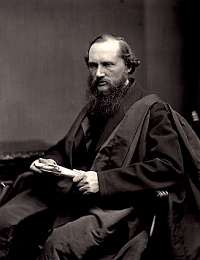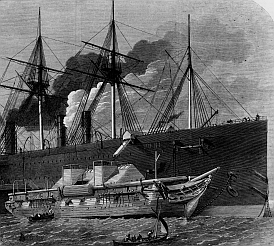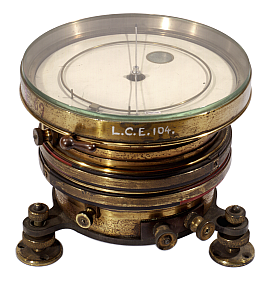William Thomson
1824 – 1907

Sir William Thomson, 1st Baron Kelvin of Largs, engineer and physicist who was instrumental in the success of the electric telegraph
Engineering Achievements
It was his engineering work that made Lord Kelvin most famous and wealthy in his lifetime. His most notable engineering achievement was his contribution to the first successful laying of a transatlantic telegraph cable from Ireland to Newfoundland. He was deeply involved in the technical specification of the cable, in the invention of instruments of adequate sensitivity to identify the signals and in the laying of the cable itself. He was appointed as 'electrician' on board the cable layer HMS Agamemnon in 1857 and was in sole charge for the final successful installation using the "Great Eastern" in 1866.
He acted as a consulting engineer throughout his life: for example, he was an adviser to the British Aluminium Company for the design of the smelter at Foyers and to the Niagara Commission for hydro work. He invented a range of measuring instruments including the ammeters, voltmeters, and compasses for ship navigation and did fundamental theoretical and development work on refrigeration and the use of heat pumps. He was also an active industrialist as a partner in a number of firms that manufactured instruments based on his inventions.
Uniquely, he was asked to serve three terms as President of what became the Institution of Electrical Engineers (originally known as the Society of Telegraph Engineers and Electricians).
His Life
-
1824 Born 26th June in Belfast Northern Ireland to a father of Scottish descent and a Scottish mother
-
1832 Age: 8 Thomson family moved to Glasgow
-
1834 Age: 10 Enrolled at Glasgow University
-
1841 Age: 16 On Fourier's Expansions of Functions in Trigonometrical Series Cambridge Mathematical Journa
-
1841 Age: 17 Enrolled at Cambridge University
-
1845 Age: 21 Graduated from Cambridge University as Second Wrangler and Smith's Prizeman
-
1846 Age: 22 Appointed to Chair of Natural Philosophy at the University of Glasgow
-
1847 Age: 22 Elected Fellow of the Royal Society of Edinburgh on 1st February
-
1856 Age: 32 Awarded Royal Medal by Royal Society
-
1859 Age: 35 Honorary Member of the Institution of Engineers & Shipbuilders in Scotland
-
1866 Age: 42 Telegraph cable laid across the Atlantic for first time
-
1866 Age: 42 Knighted for his work on the transatlantic cable
-
1871 Age: 47 President of the British Association for the Advancement of Science
-
1873 Age: 49 President of The Royal Society of Edinburgh
-
1874 Age: 50 President of the Society of Telegraph Engineers and Electricians
-
1883 Age: 59 Awarded Copley Medal by Royal Society
-
1888 Age: 64 Developed the ammeter for the early electric industry
-
1889 Age: 64 President of the Institution of Electrical Engineers (2nd term)
-
1890 Age: 66 President of The Royal Society of London
-
1892 Age: 68 President of the Institute of Marine Engineers
-
1892 Age: 68 Elevated to peerage as Baron Kelvin of Largs, the nation's first engineer or scientist Lord
-
1902 Age: 78 Fifth of twelve inaugural appointments to Order of Merit
-
1902 Age: 78 Privy Counsellor
-
1904 Age: 80 Chancellor, University of Glasgow
-
1905 Age: 81 Awarded John Fritz Medal by American Association of Engineering Societies
-
1907 Age: 83 President of the Institution of Electrical Engineers (3rd term)
-
1907 Age: 83 Died 17th December at Netherhall, Largs, Ayrshire. Buried in Westminster Abbey on 23rd December
His Legacy
Lord Kelvin tends to be now remembered as a physicist for his work on the temperature scale (he was the first to recognise that there is a minimum temperature that matter can reach) and in the formulation of the Laws of Thermodynamics. He made many other fundamental contributions to physics. But Thomson himself believed that "the life and soul of science is its practical application." The footprint of many of his scientific discoveries and engineering inventions can be identified in modern engineering practice. His combined genius as a theoretical scientist/mathematician and as a hands-on engineer/inventor may be unparalleled worldwide.
More Information
Lord Kelvin, An Account of his Scientific Life and Work Andrew Gray, London, 1908
The life of William Thomson, Baron Kelvin of Largs: Volume I and Volume II Silvanus P Thompson, London: Macmillan, 1910
Lord Kelvin, His Life and Work Alexander Russell, London, 1912
Ten British Physicists of the Nineteenth Century Alexander MacFarlane. New York. 1919
Lord Kelvin: his influence on electrical measurements and units Paul Tunbridge, London: Peregrinus, 1992
Kelvin's Instruments and the Kelvin Museum George Green & John T Lloyd, Glasgow, 1970
Lord Kelvin, the Dynamic Victorian Harold I Sharlan and Tiby Sharlin, Penn State University Press, 1979
Kelvin: Life, Labours and Legacy Raymond Flood, Mark McCartney, Andrew Whitaker, Oxford University Press, 2008
Degrees Kelvin: a Tale of Genius, Invention, and Tragedy David Lindley, Washington, 2004
Lord Kelvin: Revolutionary Scientist is a permanent display at the Hunterian Museum, Glasgow
The Kelvin Statue in Glasgow's Kelvin Way, Kelvingrove Park unveiled in 1908
The Kelvin Statue in Belfast Botanic Gardens
Buried and commemorated by stained glass window in Westminster Abbey. Inscription "In memory of Baron Kelvin of Largs. Engineer, Natural Philosopher. B.1824.D.1907"
A wall plaque near Thomson's birthplace in Belfast
There are 30 portraits of William Thomson, Baron Kelvin in the National Portrait Gallery.
Oxford Dictionary of National Biography entry (full text available to subscribers and UK library members)
-

Telegraph cable being loaded onto the Great Eastern, 1866
-

Lord Kelvin's moving coil galvanometer ammeter, 1888
-

Electrostatic voltmeter patented by Lord Kelvin
-

Royal Philosophical Society of Glasgow commemorative stone in Glasgow Necropolis adjacent to the family gravestone
-

The Thomson family gravestone in Glasgow Necropolis. Kelvin's name at foot noting his burial in Wesminster Abbey

